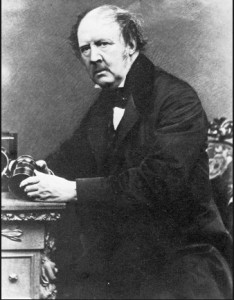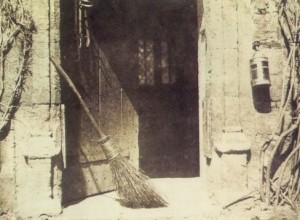Without a doubt, every antique store and flea market from California to New York somewhere has a box of photographs – black and white, early Kodaks, or even tintypes… often warped, mirrored, faded – if you are reading this blog it is assumed that at some point or another your interest in antiquarian books and materials has drawn you to such an establishment, and you have at least fingered through a box of photographs labeled “.10 each or 15 for $1.00”. Why is it, then, that those photographs are (seemingly) worthless, while there are photograph albums offered by booksellers with the same types of prints for thousands of dollars? As with all things antiquarian – provenance, condition and interest levels dictate the differences between a bin full of late 19th century silver-gelatin prints and an album full of un-faded, unaltered albumen photographs.
Photography in the Early 19th Century
The name William Henry Fox Talbot is known throughout the world as a British inventor, author and photographer of great significance. Talbot claimed experiments in photography as early as 1834, and in 1841 announced his invention of the calotype (also called the Talbotype) process, a process that reflected the work of many of Talbot’s predecessors, such as John Herschel and Thomas Wedgwood. One of Talbot’s main contributions to this fledgling art included creating a photographic image through the use of a negative from which a positive print could be made (though those terms were previously coined by Herschel, Talbot demonstrated the technique with ease). Talbot’s early discoveries culminated in his pioneer finding that silver chloride was the silver compound “most suitable for photographic printing, and to discover how to use it most effectively” (O’Reilly, p. 1). Talbot’s negative to positive printing could also be said to be one of the most important inventions in the field of photography as it allowed the photographer to create numerous prints off of a single negative, simply by exposing more paper to the image. As you will see later, other early forms of photography (such as the popular Daguerreotype process), were not able to form several images from a single exposure.
Now, the art of photography has developed significantly since Talbot began his experiments in rural England. If this blog were to describe every type of photographic print process and the differences and nuances between them all, we would quickly lose the followers we have so far gained. Suffice to say, the history of photographic prints is as diverse and intricate as any popular invention might be. Unfortunately, identifying photographic prints is particularly difficult for the untrained eye as even the slightest changes in the process (and in the final product) can be difficult to observe if you are not sure what to look for.
Identifying Photographic Prints in the Late 19th and Early 20th Centuries
Photography in this time falls into two distinct categories, True Photographs and Photomechanical Prints. Photomechanical Prints are images not formed directly from exposure to light or from a negative, and are rather more often “mass-produced.” These mechanical techniques include Halftone Illustrations (which some may recognize by their dotted appearance when viewed with a scope) and Photogravure, among others. These prints, while still able to be artistic and popular in their own right, are not usually as desirable as True Photographs when it comes to collectors and institutions. True Photographs encompass many other types.
True Photographs include, as stated, many other processes. Some of their results may sound familiar, some not so much. Salted Paper Prints, Cyanotypes, Platinotypes, Albumen Prints, Gelatin and Collodion Printing-Out Papers, Gelatin Developing-Out Papers… all of these, despite their somewhat extreme differences, are examples of True Photographs. They are placed into categories depending on characteristics such as the appearance of their paper fibers, their hues, and, most interestingly, their condition. Signs of fading, mirroring (the slight silvery hue to the darker areas of the photograph due to silver oxidation), warping and cracking can all contribute to telling the difference between the many types of “true” photography.
Curious about an image you have? Try http://www.graphicsatlas.org/ to help you identify your items.
Photography as a Popular Pastime
The Daguerreotype studio boomed early in the photographic print age in the mid 1800s. Other early photographic processes included the Salted Paper Print and the Albumen Print. Albumen Prints were quite possibly the most popular type of photographic process, as they are the most widely found today. Around the 1860s and 1870s a certain type of photographic style emerged, a Carte de Visite (quite literally, a Visiting Card) that was traded between friends and family, and most notably took the place of the general “Calling Card” that social guests would deliver to households they stopped in to see. Along with these Cartes de Visite and their cousins “Cabinet Cards”, photography moved into an age of cabinet cards and other studio portraits. Silver gelatin and Matte Collodion Printing-Out Papers and Developing-Out Papers (whose main differences lie in the process by which the image appears – DOP images appear during chemical development, whereas POP images appear on their exposure to sunlight) were quite popular as forms of portraiture, and were also some of the most popular forms of photography for the average civilian to produce at home.
Photography in Books
The first book ever to be illustrated through the photographic process was produced by none other than William Henry Fox Talbot, with his book The Pencil of Nature, published in 1844 with his own calotypes pasted into the book. The text within the book details Talbot’s calotype process used for each individual photograph. Each photograph within Talbot’s work were laid in and pasted by hand, not to mention taken and developed by the inventor as well. Though the book was less popular than Talbot expected, it paved the way for an idea that (eventually) became a bit of a phenomenon – illustrating books with photographic prints. Despite the fact that many “jumped on the bandwagon” and illustrated works with photography in mid-to-late 19th C, “in many traditional libraries the illustrations to a book, and its illustrator, were often placed in a role secondary to the author – even in situations when the illustrations were the dominant concern of that work” (Johnson, Nineteenth-Century Photography). This is no longer so. The book trade often sees works collected solely for the photographer or the images represented within a work, the text often being of little to no concern to such a collector.
Photograph albums, on the other hand, can be a different story. Eugenia Parry Janis writes “A love of subject matter leads the bookseller to photographs. He is satisfied to present photographic discoveries which have engaged his attention as they act in collaboration with needs of descriptive science, exploration, documentation or poetic evocation. It is a special quality of photographs to be able to enter into reciprocal relationships with words… The most discriminating private collections of photographs today owe much to booksellers’ at times obsessive, and even indiscriminate salvaging and rescuing of photographs destined for the incinerator. Photographs were not saved because they necessarily conformed to prevailing standards of beauty; they were saved for the richness of what they presented.” (Charles B. Wood III, Catalogue 37). Therefore, when looking through photographic albums, individual photographs, and books illustrated with photographs, it is a great find when the photos are in impeccable condition. However, more often than not, photographs are collected for what they represent – a moment in history, a fashion style, an area of the world, a political event – rather than because of their condition and artistic beauty.
In a catalogue later this month we will offer examples of all of the above – individual photographs, photo albums, and books illustrated with true photographs. Featuring a wide range of subjects, from military bases to train catalogues to family vacations, there is certain to be something of interest to everyone.
*The only reason we at Tavistock Books know any of this information on Photographic Prints is from taking James M. Reilly and Ryan Boatright’s course on these processes at University of Virginia’s Rare Book School. A fair warning – this has been a highly condensed and extremely terse outline in comparison to their course, a course officially endorsed by Tavistock Books!





